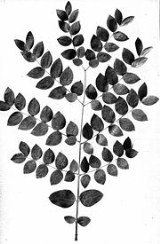
Kentucky coffeetree
Encyclopedia
The Kentucky Coffeetree, Gymnocladus dioicus, is a tree
in the subfamily Caesalpinioideae
of the pea family Fabaceae
, native to the midwest
of North America
.
Ontario
, Canada
and in the United States
from Kentucky
(where it was first encountered by Europeans) and western Pennsylvania
in the east, to Kansas
, eastern Nebraska
, and southeastern South Dakota
in the west, to southern Wisconsin
and Michigan
in the north, and to northern Louisiana
in the south. It was formerly the state tree of Kentucky
.
The Kentucky Coffeetree is a relatively fast-growing tree and generally grows in parks and along city streets for ornamental purposes. The tree is typically long-lived however often appears dead for the first six months of its growth. This is because the Kentucky Coffeetree sheds its leaves early during the fall and therefore appears bare for up to 6 months. The naked appearance of the tree is reflected through the Kentucky Coffeetree's Greek genus name: γυμνοκλαδυς = "naked branch." (Barnes, Wagner at el. 1977) from Michigan Trees.
Like the Sumac
, branches are totally destitute of fine spray; smaller branches are thick, blunt, clumsy and lumpish. While other trees lose their leaves, along their twigs and branchlets are borne the buds, the hope and the promise of the coming year. But the Gymnocladus seems so destitute of these that the French in Canada named it Chicot, the dead tree. Even when spring comes, it gives no apparent recognition of light and warmth until nearly every other tree is in full leaf. The casual observer says it bears no winter buds, but there is a tiny pair, wrapped in down and wool, lying sleeping in the axil of every last year's leaf.
Among the trees of the eastern United States, there are two others with similarly large leaves: the Honey locust
(Gleditsia triacanthos) and the Devil's Walking-Stick
(Aralia spinosa). The expanding leaves are conspicuous because of the varied colors of the leaflets; the youngest are bright pink, while those which are older vary from green to bronze.
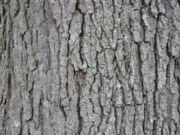 The bark is ash-gray and scaly, flaking similarly to black cherry
The bark is ash-gray and scaly, flaking similarly to black cherry
, but more so. The flower
s are dioecious
, and the fruit
is a hard-shelled bean in heavy, woody, thick-walled pods filled with sweet, thick, gooey pulp. The shape of the pods varies somewhat: pod length ranges from about 12.7 to 25.4 cm; unfertilized female trees may bear miniature seedless pods. The beans contain the toxin
cytisine
.
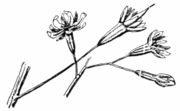
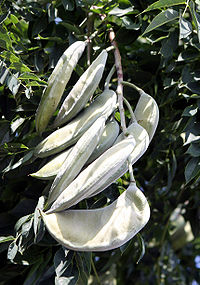
It is one of three species in the genus Gymnocladus, the other two being native to eastern Asia
. These are Chinese Coffeetree Gymnocladus chinensis in central China, and Burmese Coffeetree Gymnocladus burmanicus in Burma.
The name is sometimes hyphenated as 'coffee-tree'; the form 'coffeetree' here is as used officially by the United States Forest Service
.
The Kentucky Coffeetree is a "species of the midwestern states, reaching its northern limit in Michigan" .
This tree usually occurs as widely dispersed individuals or small colonial groups with interconnected root systems. This tree is found in floodplains and river valleys but is also sometimes seen on rocky hillsides and limestone woods. In the northeastern part of its range, seemingly natural groves of this tree are actually associated with known prehistoric village sites. In some parts of its range, this tree may be used as an indicator of the presence of limestone or of calcareous soils.
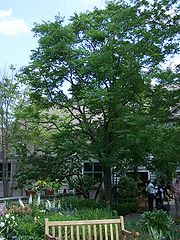
s and park
s. The peculiarly late-emerging and early-dropping leaves, coupled with the fact that the large leaves mean few twigs in the winter profile, make it a tree that is ideal for urban shading where winter sunlight is to be maximized (such as in proximity to solar
hot-air systems).
It is often planted because of its unique appearance and interesting character. There are several Kentucky Coffee trees at Mount Vernon
, in the gardens along the path leading up to the house of George Washington
.
Trees prefer a rich moist soil, such as bottom lands. Its growth is largely unaffected by heat, cold, drought, insects, disease, road salt, ice, and alkaline soil.
Kentucky Coffeetree is easy to grow from seed. Filing the seedcoat by hand with a small file, and then soaking the seeds in water for 24 hours will ensure rapid germination. Propagation
is also easy from dormant root cuttings.
The Kentucky Coffeetree is typically found on "alluvial soils of river and flood plains and nearby terraces" . Here it can form large clonal colonies
, reproducing by shoots sprouting from roots.
in times of poverty. They are a very inferior substitute for real coffee, and caution should be used in trying them as they are poisonous in large quantities.
The pods, preserved like those of the tamarind
, are said to be wholesome and slightly aperient.
Toxicity
The plant is toxic to some animals.
s. It has very little sapwood.
Tree
A tree is a perennial woody plant. It is most often defined as a woody plant that has many secondary branches supported clear of the ground on a single main stem or trunk with clear apical dominance. A minimum height specification at maturity is cited by some authors, varying from 3 m to...
in the subfamily Caesalpinioideae
Caesalpinioideae
Caesalpinioideae is a botanical name at the rank of subfamily, placed in the large family Fabaceae or Leguminosae. Its name is formed from the generic name Caesalpinia....
of the pea family Fabaceae
Fabaceae
The Fabaceae or Leguminosae, commonly known as the legume, pea, or bean family, is a large and economically important family of flowering plants. The group is the third largest land plant family, behind only the Orchidaceae and Asteraceae, with 730 genera and over 19,400 species...
, native to the midwest
Midwestern United States
The Midwestern United States is one of the four U.S. geographic regions defined by the United States Census Bureau, providing an official definition of the American Midwest....
of North America
North America
North America is a continent wholly within the Northern Hemisphere and almost wholly within the Western Hemisphere. It is also considered a northern subcontinent of the Americas...
.
Introduction
The range is limited, occurring from SouthernSouthern Ontario
Southern Ontario is a region of the province of Ontario, Canada that lies south of the French River and Algonquin Park. Depending on the inclusion of the Parry Sound and Muskoka districts, its surface area would cover between 14 to 15% of the province. It is the southernmost region of...
Ontario
Ontario
Ontario is a province of Canada, located in east-central Canada. It is Canada's most populous province and second largest in total area. It is home to the nation's most populous city, Toronto, and the nation's capital, Ottawa....
, Canada
Canada
Canada is a North American country consisting of ten provinces and three territories. Located in the northern part of the continent, it extends from the Atlantic Ocean in the east to the Pacific Ocean in the west, and northward into the Arctic Ocean...
and in the United States
United States
The United States of America is a federal constitutional republic comprising fifty states and a federal district...
from Kentucky
Kentucky
The Commonwealth of Kentucky is a state located in the East Central United States of America. As classified by the United States Census Bureau, Kentucky is a Southern state, more specifically in the East South Central region. Kentucky is one of four U.S. states constituted as a commonwealth...
(where it was first encountered by Europeans) and western Pennsylvania
Pennsylvania
The Commonwealth of Pennsylvania is a U.S. state that is located in the Northeastern and Mid-Atlantic regions of the United States. The state borders Delaware and Maryland to the south, West Virginia to the southwest, Ohio to the west, New York and Ontario, Canada, to the north, and New Jersey to...
in the east, to Kansas
Kansas
Kansas is a US state located in the Midwestern United States. It is named after the Kansas River which flows through it, which in turn was named after the Kansa Native American tribe, which inhabited the area. The tribe's name is often said to mean "people of the wind" or "people of the south...
, eastern Nebraska
Nebraska
Nebraska is a state on the Great Plains of the Midwestern United States. The state's capital is Lincoln and its largest city is Omaha, on the Missouri River....
, and southeastern South Dakota
South Dakota
South Dakota is a state located in the Midwestern region of the United States. It is named after the Lakota and Dakota Sioux American Indian tribes. Once a part of Dakota Territory, South Dakota became a state on November 2, 1889. The state has an area of and an estimated population of just over...
in the west, to southern Wisconsin
Wisconsin
Wisconsin is a U.S. state located in the north-central United States and is part of the Midwest. It is bordered by Minnesota to the west, Iowa to the southwest, Illinois to the south, Lake Michigan to the east, Michigan to the northeast, and Lake Superior to the north. Wisconsin's capital is...
and Michigan
Michigan
Michigan is a U.S. state located in the Great Lakes Region of the United States of America. The name Michigan is the French form of the Ojibwa word mishigamaa, meaning "large water" or "large lake"....
in the north, and to northern Louisiana
Louisiana
Louisiana is a state located in the southern region of the United States of America. Its capital is Baton Rouge and largest city is New Orleans. Louisiana is the only state in the U.S. with political subdivisions termed parishes, which are local governments equivalent to counties...
in the south. It was formerly the state tree of Kentucky
Kentucky
The Commonwealth of Kentucky is a state located in the East Central United States of America. As classified by the United States Census Bureau, Kentucky is a Southern state, more specifically in the East South Central region. Kentucky is one of four U.S. states constituted as a commonwealth...
.
Description
Varies from 18 to 21 meters (60–70 feet) high with a spread of 12–15 meters (40–50 feet) and a trunk up to one meter (3 feet) in diameter. A 10-year-old sapling will stand about 4 meters (13 feet) tall. It usually separates 3 to 4½ meters (10–15 feet) from the ground into three or four divisions which spread slightly and form a narrow pyramidal head; or when crowded by other trees, sending up one tall central branchless shaft to the height of 15–21 m (50–70 ft). Branches stout, pithy, and blunt; roots fibrous.The Kentucky Coffeetree is a relatively fast-growing tree and generally grows in parks and along city streets for ornamental purposes. The tree is typically long-lived however often appears dead for the first six months of its growth. This is because the Kentucky Coffeetree sheds its leaves early during the fall and therefore appears bare for up to 6 months. The naked appearance of the tree is reflected through the Kentucky Coffeetree's Greek genus name: γυμνοκλαδυς = "naked branch." (Barnes, Wagner at el. 1977) from Michigan Trees.
Like the Sumac
Sumac
Sumac is any one of approximately 250 species of flowering plants in the genus Rhus and related genera, in the family Anacardiaceae. Sumacs grow in subtropical and temperate regions throughout the world, especially in Africa and North America....
, branches are totally destitute of fine spray; smaller branches are thick, blunt, clumsy and lumpish. While other trees lose their leaves, along their twigs and branchlets are borne the buds, the hope and the promise of the coming year. But the Gymnocladus seems so destitute of these that the French in Canada named it Chicot, the dead tree. Even when spring comes, it gives no apparent recognition of light and warmth until nearly every other tree is in full leaf. The casual observer says it bears no winter buds, but there is a tiny pair, wrapped in down and wool, lying sleeping in the axil of every last year's leaf.
Among the trees of the eastern United States, there are two others with similarly large leaves: the Honey locust
Honey locust
The Honey locust, Gleditsia triacanthos, is a deciduous tree native to central North America. It is mostly found in the moist soil of river valleys ranging from southeastern South Dakota to New Orleans and central Texas, and as far east as eastern Massachusetts.-Description:Honey locusts, Gleditsia...
(Gleditsia triacanthos) and the Devil's Walking-Stick
Aralia spinosa
Aralia spinosa, commonly known as Devil's Walkingstick, is a woody species of plants in the genus Aralia, family Araliaceae, native to eastern North America. The various names refer to the viciously sharp, spiny stems, petioles, and even leaf midribs...
(Aralia spinosa). The expanding leaves are conspicuous because of the varied colors of the leaflets; the youngest are bright pink, while those which are older vary from green to bronze.

Black Cherry
Prunus serotina, commonly called black cherry, wild black cherry, rum cherry, or mountain black cherry, is a woody plant species belonging to the genus Prunus...
, but more so. The flower
Flower
A flower, sometimes known as a bloom or blossom, is the reproductive structure found in flowering plants . The biological function of a flower is to effect reproduction, usually by providing a mechanism for the union of sperm with eggs...
s are dioecious
Plant sexuality
Plant sexuality covers the wide variety of sexual reproduction systems found across the plant kingdom. This article describes morphological aspects of sexual reproduction of plants....
, and the fruit
Fruit
In broad terms, a fruit is a structure of a plant that contains its seeds.The term has different meanings dependent on context. In non-technical usage, such as food preparation, fruit normally means the fleshy seed-associated structures of certain plants that are sweet and edible in the raw state,...
is a hard-shelled bean in heavy, woody, thick-walled pods filled with sweet, thick, gooey pulp. The shape of the pods varies somewhat: pod length ranges from about 12.7 to 25.4 cm; unfertilized female trees may bear miniature seedless pods. The beans contain the toxin
Toxin
A toxin is a poisonous substance produced within living cells or organisms; man-made substances created by artificial processes are thus excluded...
cytisine
Cytisine
Cytisine, also known as baphitoxine and sophorine, is a pyridine-like alkaloid. In medical use, it improves the rate of smoking cessation. It is less effective but much cheaper than similar products. Its structure is similar to nicotine and has similar pharmacological effects...
.

- Bark: Dark gray, deeply fissured, surface scaly. Branchlets at first coated with short reddish down.
- Wood: Light brown; heavy, strong, coarse-grained; durable in contact with the ground, takes a fine polish. Sp. gr., 0.6934; weight of cu. ft., 43.21 lb (19.6 kg).
- Winter buds: Minute, depressed in downy cavities of the stem, two in the axil of each leaf, the smaller sterile. Bud scales two, ovate, coated with brown tomentum and growing with the shoot, become orange green, hairy and about one inch long, before they fall.
- Leaves: Alternate, bi-pinnately compound, ten to fourteen pinnate, lowest pinnae reduced to leaflets, the other seven to thirteen foliate. One to three feet long, eighteen to twenty-four inches broad, by the greater development of the upper pairs of pinnae. Leaf stalks and stalks of pinnae, are terete, enlarged at base, smooth when mature, pale green, often purple on the upper side. Leaflets ovate, two to two and one-half inches long, wedge-shaped or irregularly rounded at base, with wavy margin, acute apex. They come out of the bud bright pink, but soon become bronze green, smooth and shining above. When full grown are dark yellow green above, pale green beneath. In autumn turn a bright clear yellow. Stipules leaf-life, lanceolate, serrate, deciduous.
- Flowers: June. Dioecious by abortion, terminal, greenish white. Staminate flowers in a short racemen-like corymb three to four inches (102 mm) long, pistillate flowers in a raceme ten to twelve inches (305 mm) long.
- Calyx: Tubular, hairy, ten-ribbed, five-lobed; lobes valvate in bud, acute, nearly equal.
- Corolla: Petals five, oblong, hairy, spreading or reflexed, imbricate in bud.
- Stamens: Ten, five long and five short, free, included; filaments thread-like; anthers orange colored, introrse; in the pistillate flower small and sterile.
- Pistil: Ovary superior, sessile, hairy, contracted into a short style, with two stigmatic lobes; ovules in two rows.
- Fruit: Legume, six to ten inches (254 mm) long, one and one-half to two inches wide, somewhat curved, with thickened margins, dark reddish brown with slight glaucous bloom, crowned with remnant of the styles. Stalks and inch or two long. Seeds six to nine, surrounded by a thick layer of dark, sweet pulp.

Taxonomy
Gymnocladus (γυμνοκλαδυς) is of Greek derivation and refers to the stout branches destitute of spray.It is one of three species in the genus Gymnocladus, the other two being native to eastern Asia
Asia
Asia is the world's largest and most populous continent, located primarily in the eastern and northern hemispheres. It covers 8.7% of the Earth's total surface area and with approximately 3.879 billion people, it hosts 60% of the world's current human population...
. These are Chinese Coffeetree Gymnocladus chinensis in central China, and Burmese Coffeetree Gymnocladus burmanicus in Burma.
The name is sometimes hyphenated as 'coffee-tree'; the form 'coffeetree' here is as used officially by the United States Forest Service
United States Forest Service
The United States Forest Service is an agency of the United States Department of Agriculture that administers the nation's 155 national forests and 20 national grasslands, which encompass...
.
Distribution
The Kentucky Coffeetree, Gymnocladus dioicus, is considered a rare tree species. "Rare species are those that are so uncommon that they should be monitored to determine whether their populations are becoming threatened" . It is widely dispersed, but rare.The Kentucky Coffeetree is a "species of the midwestern states, reaching its northern limit in Michigan" .
This tree usually occurs as widely dispersed individuals or small colonial groups with interconnected root systems. This tree is found in floodplains and river valleys but is also sometimes seen on rocky hillsides and limestone woods. In the northeastern part of its range, seemingly natural groves of this tree are actually associated with known prehistoric village sites. In some parts of its range, this tree may be used as an indicator of the presence of limestone or of calcareous soils.

Cultivation
Gymnocladus dioicus is cultivated by specialty tree plant nurseries as an ornamental tree for planting in gardenGarden
A garden is a planned space, usually outdoors, set aside for the display, cultivation, and enjoyment of plants and other forms of nature. The garden can incorporate both natural and man-made materials. The most common form today is known as a residential garden, but the term garden has...
s and park
Park
A park is a protected area, in its natural or semi-natural state, or planted, and set aside for human recreation and enjoyment, or for the protection of wildlife or natural habitats. It may consist of rocks, soil, water, flora and fauna and grass areas. Many parks are legally protected by...
s. The peculiarly late-emerging and early-dropping leaves, coupled with the fact that the large leaves mean few twigs in the winter profile, make it a tree that is ideal for urban shading where winter sunlight is to be maximized (such as in proximity to solar
Renewable energy
Renewable energy is energy which comes from natural resources such as sunlight, wind, rain, tides, and geothermal heat, which are renewable . About 16% of global final energy consumption comes from renewables, with 10% coming from traditional biomass, which is mainly used for heating, and 3.4% from...
hot-air systems).
It is often planted because of its unique appearance and interesting character. There are several Kentucky Coffee trees at Mount Vernon
Mount Vernon
The name Mount Vernon is a dedication to the English Vice-Admiral Edward Vernon. It was first applied to Mount Vernon, the Virginia estate of George Washington, the first President of the United States...
, in the gardens along the path leading up to the house of George Washington
George Washington
George Washington was the dominant military and political leader of the new United States of America from 1775 to 1799. He led the American victory over Great Britain in the American Revolutionary War as commander-in-chief of the Continental Army from 1775 to 1783, and presided over the writing of...
.
Trees prefer a rich moist soil, such as bottom lands. Its growth is largely unaffected by heat, cold, drought, insects, disease, road salt, ice, and alkaline soil.
Kentucky Coffeetree is easy to grow from seed. Filing the seedcoat by hand with a small file, and then soaking the seeds in water for 24 hours will ensure rapid germination. Propagation
Plant propagation
Plant propagation is the process of creating new plants from a variety of sources: seeds, cuttings, bulbs and other plant parts. Plant propagation can also refer to the artificial or natural dispersal of plants.-Sexual propagation :...
is also easy from dormant root cuttings.
The Kentucky Coffeetree is typically found on "alluvial soils of river and flood plains and nearby terraces" . Here it can form large clonal colonies
Clonal colony
A clonal colony or genet is a group of genetically identical individuals that have grown in a given location, all originating vegetatively from a single ancestor. In plants, an individual in such a population is referred to as a ramet...
, reproducing by shoots sprouting from roots.
Food
The common name "coffeetree" derives from the use of the roasted seeds as a substitute for coffeeCoffee
Coffee is a brewed beverage with a dark,init brooo acidic flavor prepared from the roasted seeds of the coffee plant, colloquially called coffee beans. The beans are found in coffee cherries, which grow on trees cultivated in over 70 countries, primarily in equatorial Latin America, Southeast Asia,...
in times of poverty. They are a very inferior substitute for real coffee, and caution should be used in trying them as they are poisonous in large quantities.
The pods, preserved like those of the tamarind
Tamarind
Tamarind is a tree in the family Fabaceae. The genus Tamarindus is monotypic .-Origin:...
, are said to be wholesome and slightly aperient.
Toxicity
The plant is toxic to some animals.
Woodworking
The wood is used both by cabinetmakers and carpenterCarpenter
A carpenter is a skilled craftsperson who works with timber to construct, install and maintain buildings, furniture, and other objects. The work, known as carpentry, may involve manual labor and work outdoors....
s. It has very little sapwood.

